Not Winter Camping? Why Not!
By Karen Berger
Here are five great winter trips that range from the top of Texas to sleeping inside a yurt. A yurt? What the heck is a yurt?
1. Hiking in Ocala National Forest, Florida
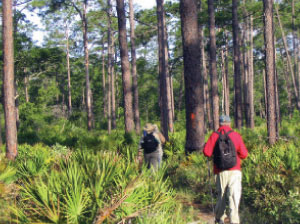 If you are looking for a destination where the chance of snow is reliably zero, the Ocala National Forest, in the middle of Florida, promises winter hiking without the winter.
If you are looking for a destination where the chance of snow is reliably zero, the Ocala National Forest, in the middle of Florida, promises winter hiking without the winter.
About 65 miles of the Florida National Scenic Trail cross the forest. The Ocala segment is one of the trail’s highlights, home to a wide diversity of subtropical plants and animals.
Winter temperatures average in the 50’s and can climb into the 70’s. However, bring a three-season sleeping bag and clothing that can be layered for the rare nights when temperatures dip into the 30’s.
Winter is deer hunting season, so be sure to wear blaze-orange vests.
The basics: Located between Gainesville and Orlando. Florida Highway 40 bisects the forest. www.dep.state.fl.us/gwt/guide/regions/crossflorida/trails/ocala_nat_forest.htm; www.fs.fed.us/r8/florida/.
2. Snowshoeing or Cross-Country Skiing in State Forest State Park, Colorado
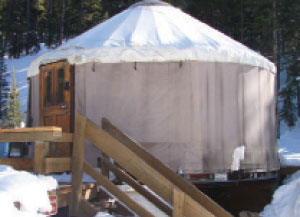 Yurts are round, tented, temporary dwellings originally used by nomads on the steppes of Asia. In the United States, they’ve gained popularity as simple, environmentally friendly guesthouses.
Yurts are round, tented, temporary dwellings originally used by nomads on the steppes of Asia. In the United States, they’ve gained popularity as simple, environmentally friendly guesthouses.
In Colorado’s State Forest State Park, yurts offer a welcome refuge for snowshoers and skiers traveling through the northern part of the state’s aptly named Never Summer Range and the western side of the Medicine Bow Mountains. These circular canvas-and-wood structures, each built on a wooden deck, are located between a quarter mile and three miles from the trailhead. Once you arrive, there are plenty more trails to explore.
Facilities include a woodstove, beds and mattress pads, cooking equipment (including a propane cookstove, pots, pans, dishes, and silverware), a lantern, and an outhouse. The yurts can sleep between five and nine people in beds, plus two or three more on floor pads.
The basics: Located on Colorado Highway 14, two hours west of Fort Collins. www.neversummernordic.com, http://parks.state.co.us/Parks/stateforest. Yurts and cabins are rented in their entirety. $60 to $160 a night, depending on the facility and the date.
3. Hiking or Snowshoeing in Shenandoah National Park, Virginia
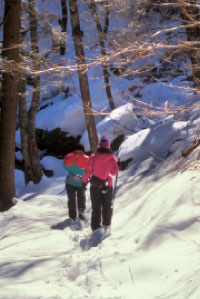 Shenandoah National Park is one of the most visited national parks in the country. It boasts the famed Skyline Drive, which runs parallel to the Appalachian Trail for the length of the park. But in winter, the crowds are gone, leaving Shenandoah to a smattering of hikers who don’t mind a bit of chill.
Shenandoah National Park is one of the most visited national parks in the country. It boasts the famed Skyline Drive, which runs parallel to the Appalachian Trail for the length of the park. But in winter, the crowds are gone, leaving Shenandoah to a smattering of hikers who don’t mind a bit of chill.
This is a great place to satisfy your appetite for winter hiking. Snow levels vary tremendously: After a big storm and a long cold spell, you might be wading through the white stuff, especially at the higher elevations. But during warmer winters, the ground may be bare or covered with only light snow.
Temperatures can fall into the 20’s or, occasionally, even lower, but you won’t experience the subzero chills of mountains farther north. Winter also offers more expansive views, as the largely deciduous forest drops its leaves to reveal more of the surrounding landscape.
Best of all, the Appalachian Trail system of shelters provides cold-weather hikers a safe and comfortable place to sleep. Be prepared, however, by always carrying emergency shelter with you. This is in case you can’t make it to the next lean-to on the trail or the unlikely possibility that another group has arrived before you and claimed all the space.
Skyline Drive is sometimes closed in winter due to snow. Call for current conditions.
The basics: Located slightly more than an hour’s drive west of Washington D.C. www.nps.gov/shen/. Contact the Appalachian Trail Conservancy, www.appalachiantrail.org, for trail information and news about shuttle service schedules to the trailheads.
4. Cross-Country Skiing in Methow Valley, Washington
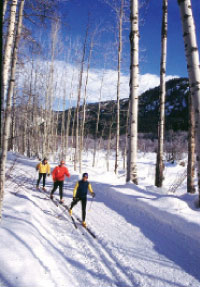 Located in north-central Washington, just east of the north Cascades and a five-hour drive from Seattle, Methow Valley is considered by some experts to be the finest Nordic ski area in the Northwest.
Located in north-central Washington, just east of the north Cascades and a five-hour drive from Seattle, Methow Valley is considered by some experts to be the finest Nordic ski area in the Northwest.
The Methow Valley Sport Trails Association’s network is one of the largest trail systems for cross-country skiing in the United States, with more than 120 miles of groomed ski trails of various skill levels. The system comprises three linked trail systems; hotels, lodges, and cabins are scattered through the valley, some right on the trail.
The Sun Mountain system, south of the valley, has terrain of varied difficulty and is a good choice for groups of mixed abilities. Mazama’s system, at the valley’s northwestern side, contains flatter, easier trails coupled with dramatic landscapes, including the icicle-covered Goat Wall.
But for a true backcountry experience, head for the Rendezvous system, where intermediate and advanced skiers can tackle more challenging terrain and stay in small backcountry cabins at night. You can even arrange to have your food delivered.
The basics: Located 200 miles east of Seattle. Hut fees $35 per night, per person. General info: www.mvsta.com. For backcountry cabins: www.methow.com/huts/info.html. For other lodging: www.methowlodging.com/.
5. Climbing Guadalupe Peak, Texas
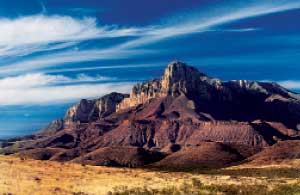 In terms of state high points, Texas’s Guadalupe Peak, elevation 8,749 feet, ranks a respectable, if
In terms of state high points, Texas’s Guadalupe Peak, elevation 8,749 feet, ranks a respectable, if
not spectacular No. 14. But of the 13 peaks that are taller, only one—Hawaii’s Mauna Kea—are climbable in winter without specialized gear.
Climbing Guadalupe in the so-called off-season is not only possible; you might find it preferable to slogging uphill in summer’s heat. But here is fair warning: When you get near the summit, you may not escape winter entirely. January and February can produce fog, frost, high winds, and sometimes even snow.
Climbing the peak is an 8.5-mile roundtrip. In addition, the Guadalupe Mountains National Park contains more than 80 miles of rugged mountain trails laced through an impressive craggy landscape.
Bring binoculars to watch the park’s unique combination of wildlife, which includes species from the Rocky Mountains, Mexico, and the Great Plains, including almost 300 species of birds, 60 species of mammals, and 64 species of reptiles and amphibians.
The basics: Location: 110 miles from El Paso; 10 miles from the New Mexico border. www.nps.gov/gumo/.
Karen Berger is the author of Backpacking and Hiking (BSA No. 34354, $20). Visit her Web site at www.hikerwriter.com.
January - February 2008 Table of Contents
Copyright © 2008 by the Boy Scouts of America. All rights thereunder reserved; anything appearing in Scouting magazine or on its Web site may not be reprinted either wholly or in part without written permission. Because of freedom given authors, opinions may not reflect official concurrence.